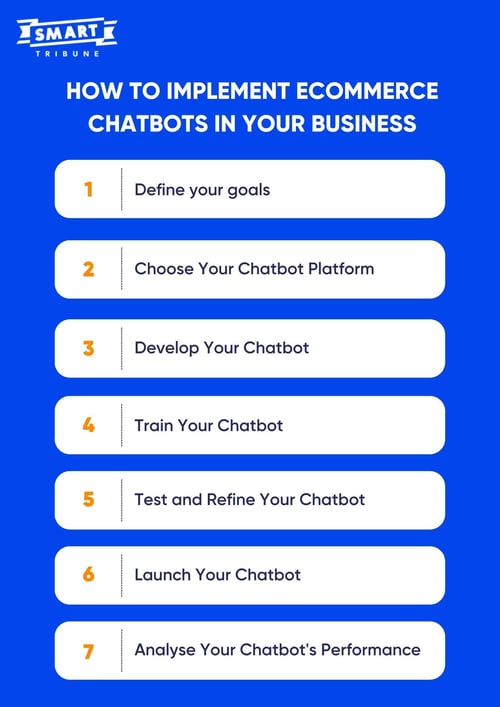
On MAY 4, 2023
Everything You Need To Know About eCommerce Chatbot In 2025
The surge in the fame of eCommerce chatbots has been tremendous in recent times. Research showed that 88% of shoppers conversed with a chatbot during the previous year. This is all attributed to the escalation in online transactions and the growth of omnichannel marketing.
We are undoubtedly facing an eCommerce chatbot revolution, with rising demands for AI-powered chatbots to enhance customer engagement, streamline sales processes, and provide personalized shopping experiences for customers.
In 2023, chatbots will have an even more prominent role in eCommerce. Thanks to the mind-blowing advancements in natural language processing (NLP) and machine learning, chatbots can now understand and respond to customer queries better and more human-like.
Today, chatbots are being integrated with other technologies, such as voice assistants and augmented reality (AR), opening up tremendous possibilities for retailers to give customers the desired immersive shopping experience.
This guide will take you on a journey into eCommerce chatbots. From how to implement chatbots in your business to best practices for eCommerce chatbot development to potential challenges and solutions, this article will give you a head start on leveraging the power of chatbots for your eCommerce business.
Table of content:
- How to implement eCommerce chatbots in your business
- Best practices for eCommerce chatbot development
- Potential challenges and solutions for eCommerce chatbots
- Future of eCommerce Chatbots
How to implement eCommerce chatbots in your business
As a business owner, there's a never-ending search for ways to improve and give customers the best experience possible. And one such way is through the use of eCommerce chatbots.
Jerry Han, CMO at PrizeRebel, adds, "These artificial-intelligence-powered virtual assistants are capable of answering frequently asked questions, providing product recommendations, responding to customer complaints, and handling multiple conversations simultaneously, making them a powerful and must-have tool for any eCommerce business."
So, how exactly do you harness the massive potential of eCommerce chatbots in your business?

1. Define your goals
Before taking any decision in your business, it's essential that you first define your goal; as this will give you a clear target, you can work toward.
You need to know what you want to achieve with your eCommerce chatbot to get the best out of it. Do you want the chatbot to help customers find products, process orders, or handle customer complaints? Answering these questions and clearly outlining your goals will help you choose the right type of chatbot for your business.
2. Choose Your Chatbot Platform
With so many chatbot platforms available, each with its strengths and weaknesses, how do you know which is right for you? It is essential to closely examine each platform's characteristics, incorporations, and cost structures to determine which is most suitable for fulfilling your business requirements.
3. Develop Your Chatbot
Once you choose your platform, the next step is developing your chatbot. And there are two options available to you - you can either decide to build your chatbot from scratch or use a chatbot builder.
No coding skills? You don't have to worry, as many chatbot builders like Dialogflow, Tars, and ManyChat allow you to create a chatbot without coding experience.
4. Train Your Chatbot
Once your chatbot development is complete, it is time to commence training it. You will need to educate the chatbot on comprehending pertinent customer inquiries and providing fitting responses. To achieve this, you must furnish your chatbot with a compilation of customer queries and their corresponding answers.
5. Test and Refine Your Chatbot
If you don't test it, there's no way to determine if your chatbot works as intended. You must assess your chatbot's reactions to various inquiries, watch for any mistakes, and enhance its responses to increase accuracy.
6. Launch Your Chatbot
Once you've tested and refined your chatbot sufficiently, it's time to launch it and show it to the world. You can launch your chatbot on your website or social media platforms depending on your business needs.
7. Analyse Your Chatbot's Performance
Failure to evaluate your chatbot's performance means leaving out one of the most crucial activities. It's advisable to track metrics like customer satisfaction, response time, and the number of conversations handled successfully to identify loopholes and improvement areas.
Improving customer experience with eCommerce chatbots
Customers' demands are evolving, and businesses should adjust to guarantee they offer their clients the ultimate satisfaction, which is vital in establishing customer loyalty. One approach businesses can use to enhance customer experience is by integrating chatbots into their customer relationship efforts.
One of the foremost benefits of utilizing e-commerce chatbots is their capability to provide personalized product recommendations to customers. These bots can scrutinize a shopper's browsing, purchase history, and preferences and leverage that data to propose products that the consumer is most likely interested in. This conserves the customer's time and heightens the probability of you making a sale.
Another considerable advantage of utilizing eCommerce chatbots is the capacity to offer your clients prompt assistance. Occasionally, your customers could have inquiries or difficulties they require immediate aid with. They might not have the patience to hold on the phone or wait for an email response.
Additionally, eCommerce chatbots may be a valuable resource for collecting customer feedback. A keen interest in your customers' post-purchase sentiments is crucial, as this can provide further insights into their preferences and dislikes about your goods or services. Analyzing this feedback can enhance the overall customer experience and facilitate better and more informed decisions.
According to Jonathan Elster, CEO at EcomHalo, "At the end of the day, eCommerce chatbots are a win-win for both businesses and customers. With their ability to provide personalized product recommendations, instant support, and gather feedback, eCommerce chatbots are a game-changer in taking customer service to the next level."
Best practices for eCommerce chatbot development
E-commerce chatbots can enhance customer engagement and contentment, provided they are correctly implemented.
To guarantee the efficiency of your chatbot, it is crucial to consider the following best practices for eCommerce:
Ensure Simplicity and User-Friendliness
Simplicity should be your guiding principle when designing your chatbot. It is imperative to have an uncomplicated interface that is easy to navigate. To avoid frustrating your customers, you must ensure that they can interact with your chatbot intuitively without having to learn a complicated sequence of commands.
Personalize the experience
To provide customers with a genuinely captivating experience, it is imperative to make personalization an essential part of your eCommerce chatbot. This involves utilizing customer behavior and preferences data to provide personalized recommendations and information.
Integrate natural language processing (NLP)
For your chatbots to reply to customer inquiries, they must initially have the capacity to grasp and analyze human language, which is feasible through NLP. Integrating NLP into your chatbot will empower you to provide customers with a more natural and intuitive experience.
Ensuring smooth integration with other systems
A method to guarantee the usefulness of your chatbot to customers is by seamlessly integrating it with other platforms and systems. For example, your chatbot must be capable of retrieving customer data from your eCommerce platform and utilizing it to furnish updates regarding order status and shipment details.
Test as much as possible
It is vital to test your chatbot extensively before launching it because one negative chatbot experience can drive away up to 30% of customers. Carrying out several rounds of testing will help you identify any issues or bugs you need to address.
When followed to the letter, these best practices will put you on the right track to creating a chatbot that genuinely engages customers and helps improve your eCommerce business.
Potential challenges and solutions for eCommerce chatbots
Even though chatbots have quickly become an essential tool for eCommerce businesses, they face many challenges and still need to be improved. Here are some potential challenges and solutions for eCommerce chatbots in 2023.
Limited Understanding of Customer Intent
One of the significant obstacles in eCommerce chatbots is their restricted capacity to comprehend the intention of customers. Shoppers typically employ diverse terms and expressions to articulate their inquiries or concerns. If your chatbot does not possess a sufficiently robust natural language processing (NLP) framework, it could encounter difficulties in comprehending them. As a result, this may lead to customer discontentment, which can result in detrimental feedback and reduced revenue.
Solution: Improved NLP and Machine Learning
The solution necessitates setting up eCommerce chatbots with sophisticated natural language processing and machine learning algorithms. Such a move would simplify the analysis of customer inquiries and enhance comprehension of their intent. Using machine learning, these chatbots can assimilate knowledge from past transactions and improve their performance as they progress, increasing client satisfaction and more profitable sales for your business.
Limited Product Knowledge
How much do your chatbots know about your products? Due to the limited product knowledge of chatbots, they may need help to provide accurate information about your products, leading to misinformation and incorrect recommendations.
Solution: Integration with Product Catalogs
Integrating chatbots with product catalogs is the most effective way to overcome this challenge. This will equip them with all the information they need to make personalized recommendations based on customer preferences, helping improve customer service and drive sales.
Lack of Sufficient Personalization
Many customers want to feel connected with the brand they patronize. And if your eCommerce chatbots cannot provide personalized experiences, it may reduce loyalty and repeat business.
Solution: Personalized Product Recommendations and Offers
To circumvent this challenge, it will be necessary to equip eCommerce chatbots with personalized product recommendations and offer engines. These engines must analyze customer behavior and preferences to provide unique recommendations and offer to customers, leading to a more satisfied customer base.
Security and Privacy Concerns
While trying to give customers the best experience, eCommerce chatbots may store sensitive customer data, such as credit card information and personal details. And if this data is not stored properly and securely, it may be vulnerable to cyberattacks, resulting in reputational damage and loss of customer trust.
Solution: Implementation of Robust Security Measures
To address this issue, eCommerce chatbots should be furnished with solid safety measures. This comprises encryption, authentication, and access control to protect valuable customer information from cyberattacks. By ensuring the security and confidentiality of customer information, businesses can demonstrate their dedication to prioritizing customer welfare, which can build trust and reliability with customers.
To sum up, eCommerce chatbots genuinely possess the capacity to transform how businesses engage with their customers. Nevertheless, businesses must tackle the previously mentioned challenges to extract the maximum benefit from them.
Future of eCommerce Chatbots
It's fascinating just thinking about the massive potential of eCommerce chatbots. Even with their current capabilities, there is inevitably more to come.
So, what exactly does the future hold for eCommerce chatbots? Let's take a look!
-
Personalization
Chatbots will become more personalized and context-aware, providing tailored recommendations and responses based on customers' preferences, purchase history, and behavior patterns. This will undoubtedly enhance the overall customer experience and increase sales conversion rates.
-
Omni-channel Integration
Chatbots will be integrated across various channels such as websites, mobile apps, social media platforms, and messaging apps. This will make it easier for businesses to provide consistent customer support and sales assistance to customers wherever they are, creating a unified customer experience.
-
Voice-Enabled Chatbots
Now that smart speakers and voice speakers are becoming more popular, we will see voice-enabled chatbots become more prominent in eCommerce. Customers can interact with chatbots conveniently using more natural language, making the shopping experience much more exciting.
-
Augmented Reality
Soon, we will start witnessing the integration of chatbots with augmented reality (AR) technology, enabling customers to envision products in 3D and experiment with them virtually before finalizing a transaction. This will give customers a more captivating involvement, encouraging them to return for further engagements.
-
Conversational Commerce
Chatbots will enhance their ability to engage in intricate conversations, empowering them to address complex customer inquiries and deliver tailored product suggestions effectively.
-
Data Analytics
Chatbots will provide businesses with valuable information into customer behavior, preferences, and, crucially, pain points. This will empower businesses to enhance their products, services, and customer care strategies to meet the evolving requirements of their customers.
Conclusion
The rise of eCommerce chatbots will revolutionize how we shop online in 2023 and beyond. These tools have already been proven to be very effective in improving customer engagement, increasing sales, enhancing the overall shopping experience, and helping eCommerce businesses stay ahead of the curve in a marketplace that is becoming increasingly competitive.
As we continue to experience more and more ground-breaking technological advancements, we can expect to see even more advanced features and capabilities added to chatbots. Whether you are a small business owner just starting or a large eCommerce enterprise, investing in chatbot technology will pay off handsomely in the long run.



.png)



